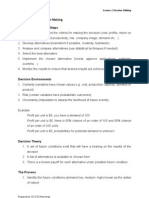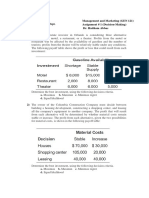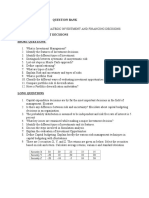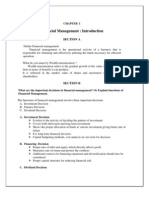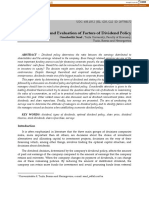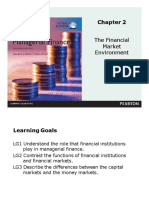Assignment
Assignment
Uploaded by
Juby JohnsonCopyright:
Available Formats
Assignment
Assignment
Uploaded by
Juby JohnsonCopyright
Available Formats
Share this document
Did you find this document useful?
Is this content inappropriate?
Copyright:
Available Formats
Assignment
Assignment
Uploaded by
Juby JohnsonCopyright:
Available Formats
Assignment
Write a note on
1. Motivation Theories
a. Aldefer’s ERG theory
b. Hezberg’s theory of motivation
c. Vroom Expectancy theory
d. Equity theory
e. Goal setting theory
2. Models of Decision making: Economic man model, Bounded rationality model and
Gamesman model (with flow diagrams)
3. Characteristics of Decision making
4. Operations system and Operations sub-system with flow diagram
5. Product Life cycle
6. Marketing mix variables
7. Recruitment - Selection (process and types)
8. Methods of training
9. Financial management - Institutes funding financial support
10. Shares and debentures
11. Corporate social responsibility
12. A client asks an estate agent to sell three properties, A, B, and C, for him and agrees to
pay him 5% commission on each sale. He specifies certain conditions. The estate agent
must sell property A first, and this he must do within 60 days. If and when A is sold,
the agent receives his 5% commission on that sale. He can either back out at this stage
or nominate and try to sell one of the remaining two properties within 60 days. If he
does not succeed in selling the nominated property in that period, he is not given the
opportunity to sell other. If he does sell it in the period, he is given the opportunity to
sell the third property on the same conditions. The following table summarizes the
prices, selling costs (incurred by the estate agent whenever a sale is made), and the
estate agent’s estimated probability of making a sale.
Property Prices of Selling cost Probability
property (Rs.) (Rs.) of sale
A 12000 400 0.7
B 25000 225 0.6
C 50000 450 0.5
Draw up an appropriate decision tree for the estate agent. What is the estate agent’s
best strategy under the EMV approach?
13. A large steel manufacturing company has three options with regard to production: (i)
produce commercially (ii) build pilot plants (iii) stop producing steel. The management
has estimated that their pilot plant, if built, has 0.8 chance of high yield and 0.2 chance
of low yield. If the pilot plant does show a high yield, management assigns a probability
of 0.75 that the commercial plant will also have a high yield. If the pilot plant shows a
low yield, there is only a 0.1 chance that the commercial plant will show a high yield.
Finally, management’s best assessment of the yield on a commercial-size plant without
building a pilot plant first has a 0.6 chance of high yield. A pilot plant will cost rupees
3,00,000. The profits earned under high and low yield conditions are Rs.1,20,00,000
and Rs.(-12,00,000), respectively. Find the optimum decision for the company using
decision tree analysis.
14. A businessman has two independent investments, A and B, available to him, but he
lacks the capital to undertake both of them simultaneously. He can choose to take A
first and then stop, or if A is successful then take B, or viceverca. The probability of
success on A is 0.7, while for B it is 0.4. Both investments require an initial capital
outlay of Rs. 2000, and both return nothing if the venture is unsuccessful. Successful
completion of A will return Rs. 3000 (over cost), successful completion of B will return
Rs.5000(over cost). Draw the decision tree and determine the best strategy.
You might also like
- Questions On Decision TreeDocument2 pagesQuestions On Decision TreePragya Chakshoo100% (8)
- Decision Tree, EMV, Decision Making Under Risk, Multistage Decision MakingDocument13 pagesDecision Tree, EMV, Decision Making Under Risk, Multistage Decision MakingGaurav Sonkar100% (9)
- Decision Tree 18Document4 pagesDecision Tree 18Kulmeet Singh100% (1)
- FIN300 Homework 4Document4 pagesFIN300 Homework 4John0% (2)
- GS On Macro Trends Sustain Mar2010Document23 pagesGS On Macro Trends Sustain Mar2010larsasiaNo ratings yet
- Decision TreeDocument3 pagesDecision TreeAjinkya AmbikeNo ratings yet
- C) Increased, Due To A Smaller Spread Between Required Return and GrowthDocument2 pagesC) Increased, Due To A Smaller Spread Between Required Return and Growthvip_thb_2007No ratings yet
- Questions Decision MakingDocument5 pagesQuestions Decision MakingShubhangi Kesharwani0% (1)
- Decision Tree AnalysisDocument4 pagesDecision Tree AnalysisSachin SinghNo ratings yet
- Decision Trees: Ans.: Invest in Y Value Rs. 4,900Document5 pagesDecision Trees: Ans.: Invest in Y Value Rs. 4,900parthibandipanNo ratings yet
- Decision Theory & Decision Tree PDFDocument5 pagesDecision Theory & Decision Tree PDFAfiq FuadNo ratings yet
- Individual Assignment For QM Novmenber 112023Document4 pagesIndividual Assignment For QM Novmenber 112023Belidet GirmaNo ratings yet
- Time-Bound Home Exam-2020: Purbanchal UniversityDocument2 pagesTime-Bound Home Exam-2020: Purbanchal UniversityEnysa DlNo ratings yet
- Decision Under The Environment of Uncertainty and Risk (New)Document5 pagesDecision Under The Environment of Uncertainty and Risk (New)Yvonne JosephNo ratings yet
- 11PPM - DecisionTheory Problems (Mod)Document3 pages11PPM - DecisionTheory Problems (Mod)Rakesh bhukyaNo ratings yet
- Decision Making Under Risk and Uncertainty-1Document4 pagesDecision Making Under Risk and Uncertainty-1lott nathanNo ratings yet
- Assignment (19.05)Document26 pagesAssignment (19.05)Faisel MohamedNo ratings yet
- Project Appraisal Assignment2Document9 pagesProject Appraisal Assignment2Shashi Bhushan SonbhadraNo ratings yet
- IAS Mains Commerce 1979Document4 pagesIAS Mains Commerce 1979SONALI DHARNo ratings yet
- Decision Analysis ExerciseDocument5 pagesDecision Analysis Exercisescm390% (1)
- Decision Theoty Sample ProblemsDocument4 pagesDecision Theoty Sample ProblemsRoshan Raheja0% (2)
- Importance of Decision Making Decision Making: The StepsDocument5 pagesImportance of Decision Making Decision Making: The Stepsshahid_hussain_41No ratings yet
- 2012 ZaDocument4 pages2012 ZaShershah KakakhelNo ratings yet
- Finance FinalDocument15 pagesFinance Finaldingdong ditchNo ratings yet
- Sem5 Dec 2020 CBCS Question PaperDocument29 pagesSem5 Dec 2020 CBCS Question Paperkilledarahmed02No ratings yet
- unit 4Document2 pagesunit 4v4vidyalekshmiNo ratings yet
- Management Sheet 1 (Decision Making Assignment)Document6 pagesManagement Sheet 1 (Decision Making Assignment)Dalia EhabNo ratings yet
- 111 Practice Final ExamsDocument27 pages111 Practice Final ExamsJohnNo ratings yet
- APM_9_-_Questions (1)Document13 pagesAPM_9_-_Questions (1)Fathima ShameehaNo ratings yet
- MBA Assignment Question BankDocument37 pagesMBA Assignment Question BankAiDLo100% (1)
- Question PaperDocument7 pagesQuestion Papertriptirajpurohit769No ratings yet
- Practice - Session 07 - Decision AnalysisDocument3 pagesPractice - Session 07 - Decision AnalysisSherly SiangtaNo ratings yet
- MEFA Important QuestionsDocument14 pagesMEFA Important Questionstulasinad123No ratings yet
- Strategic Cost Management JUNE 2022Document10 pagesStrategic Cost Management JUNE 2022Rajni KumariNo ratings yet
- Decision Trees AnalysisDocument3 pagesDecision Trees AnalysisSiddhesh AsatkarNo ratings yet
- Gujarat Technological University: InstructionsDocument3 pagesGujarat Technological University: InstructionssanketchauhanNo ratings yet
- Decision Tree Analysis-2Document1 pageDecision Tree Analysis-2Shalmali ShettyNo ratings yet
- Orbit 1Document2 pagesOrbit 1Pranav MishraNo ratings yet
- Mefa Imp+ Arryasri Guide PDFDocument210 pagesMefa Imp+ Arryasri Guide PDFvenumadhavNo ratings yet
- SFM Test 2 - Question PaperDocument4 pagesSFM Test 2 - Question PaperNimisha DamaniNo ratings yet
- GTU MBA 2018 3rd Semester Winter 2830201 Strategic Financial ManagementDocument4 pagesGTU MBA 2018 3rd Semester Winter 2830201 Strategic Financial ManagementAbhishek ChaturvediNo ratings yet
- Ques Paper Final Exam 2012-13Document2 pagesQues Paper Final Exam 2012-13Anshuman GuptaNo ratings yet
- R27 Equity Valuation Q Bank PDFDocument5 pagesR27 Equity Valuation Q Bank PDFZidane KhanNo ratings yet
- Xi-b Business Studies AssignmentDocument3 pagesXi-b Business Studies Assignmentayetio999No ratings yet
- Lesson - Firm: Dr. Ranjana AgarwalDocument25 pagesLesson - Firm: Dr. Ranjana AgarwalAdityaDhruvMansharamaniNo ratings yet
- Case QuestionsDocument2 pagesCase Questionssan75% (4)
- SAPM and FRA Prelims With Solutions 201415 PDFDocument5 pagesSAPM and FRA Prelims With Solutions 201415 PDFPratikChalkeNo ratings yet
- VenaDocument7 pagesVenasmp243No ratings yet
- Question Bank SifdDocument8 pagesQuestion Bank SifdVamsi KrishnaNo ratings yet
- MBA O.R Assignment1Document2 pagesMBA O.R Assignment1Shashank ShekharNo ratings yet
- Chapter 06 Questions and ProblemsDocument4 pagesChapter 06 Questions and ProblemshuynhhangocthuNo ratings yet
- Chapter 05 Questions and ProblemsDocument4 pagesChapter 05 Questions and ProblemshuynhhangocthuNo ratings yet
- Sample Theory questionDocument5 pagesSample Theory questionjonathan.petreeNo ratings yet
- Industrial Engineering Program: Benha UniversityDocument2 pagesIndustrial Engineering Program: Benha UniversityMohamed HassanNo ratings yet
- Sessional Examination: Master of Business Administration (MBA) Semester: IIIDocument4 pagesSessional Examination: Master of Business Administration (MBA) Semester: IIINishaTripathiNo ratings yet
- B.ST XI QP For RevisionDocument22 pagesB.ST XI QP For Revisionvarshitha reddyNo ratings yet
- ACC501 Mid Term Preparation FileDocument28 pagesACC501 Mid Term Preparation FileMujtaba AhmadNo ratings yet
- FB Practice Test 1 Set 2 SolutionsDocument11 pagesFB Practice Test 1 Set 2 SolutionsShivam Mehta100% (6)
- Important 6 & 8 Marks Questions - CMSL-Executive-RevisionDocument22 pagesImportant 6 & 8 Marks Questions - CMSL-Executive-RevisionarjunjoshiNo ratings yet
- ACC501 Mid Term Preparation FileDocument28 pagesACC501 Mid Term Preparation Fileasgharali.urbranchNo ratings yet
- Conquering Complexity in Your Business: How Wal-Mart, Toyota, and Other Top Companies Are Breaking Through the Ceiling on Profits and Growth: How Wal-Mart, Toyota, and Other Top Companies Are Breaking Through the Ceiling on Profits and GrowthFrom EverandConquering Complexity in Your Business: How Wal-Mart, Toyota, and Other Top Companies Are Breaking Through the Ceiling on Profits and Growth: How Wal-Mart, Toyota, and Other Top Companies Are Breaking Through the Ceiling on Profits and GrowthRating: 4 out of 5 stars4/5 (2)
- KM eDocument35 pagesKM eJuby JohnsonNo ratings yet
- CS4038D Data Mining: Decision TreeDocument13 pagesCS4038D Data Mining: Decision TreeJuby JohnsonNo ratings yet
- Steganalysis of Content-Adaptive Steganography Bas-2Document10 pagesSteganalysis of Content-Adaptive Steganography Bas-2Juby JohnsonNo ratings yet
- Kang Et Al 2019 Color Image Steganalysis Based On Channel Gradient Correlation 2Document13 pagesKang Et Al 2019 Color Image Steganalysis Based On Channel Gradient Correlation 2Juby JohnsonNo ratings yet
- Version Control Using GitDocument111 pagesVersion Control Using GitJuby JohnsonNo ratings yet
- Principles of Management: Recruitment SourcesDocument10 pagesPrinciples of Management: Recruitment SourcesJuby JohnsonNo ratings yet
- Main Seminar CS03Document1 pageMain Seminar CS03Juby JohnsonNo ratings yet
- Lab VIADocument6 pagesLab VIAJuby JohnsonNo ratings yet
- PresentDocument30 pagesPresentJuby JohnsonNo ratings yet
- JUBY JOHNSON - Test1Document1 pageJUBY JOHNSON - Test1Juby JohnsonNo ratings yet
- Trigger WarningDocument3 pagesTrigger WarningJuby JohnsonNo ratings yet
- Oru 12am RothanamDocument2 pagesOru 12am RothanamJuby JohnsonNo ratings yet
- Tay Yu Jie - ResumeDocument1 pageTay Yu Jie - ResumeTay Yu JieNo ratings yet
- Rally Base Rally Trading Strategy 1Document9 pagesRally Base Rally Trading Strategy 1charleskerama81No ratings yet
- 2023 Introduction To FinanceDocument40 pages2023 Introduction To FinanceNguyễn Xuân HoaNo ratings yet
- Money and Capital Markets: Financial Institutions and Instruments in A Global MarketplaceDocument18 pagesMoney and Capital Markets: Financial Institutions and Instruments in A Global MarketplaceShaikat D. AjaxNo ratings yet
- Ak 01Document5 pagesAk 01djawapinNo ratings yet
- Equity Exercises 1Document3 pagesEquity Exercises 1alcazar rtuNo ratings yet
- commerce_bcom_semester-2_2022_april_marketing-salesmanshipDocument4 pagescommerce_bcom_semester-2_2022_april_marketing-salesmanshipfaidu.lalchi50No ratings yet
- F321 - F319 - F329 Term Sheet 2016Document2 pagesF321 - F319 - F329 Term Sheet 2016Chris CarmenNo ratings yet
- Asts Bersama Big Xi Genap Smanika 2023Document10 pagesAsts Bersama Big Xi Genap Smanika 2023riva.octaaNo ratings yet
- ACC2143ACC2543 Test 1 2023Document9 pagesACC2143ACC2543 Test 1 2023kamichidorahNo ratings yet
- Economic Survey 2024Document21 pagesEconomic Survey 2024Vikram SharmaNo ratings yet
- PHD THESIS REal OPTIONSDocument204 pagesPHD THESIS REal OPTIONSEgyiri FrederickNo ratings yet
- Dematerialisation of SharesDocument29 pagesDematerialisation of SharesJayesh TadaNo ratings yet
- Elang Mahkota Teknologi: Flash NoteDocument4 pagesElang Mahkota Teknologi: Flash Noteroy95121No ratings yet
- FM MBA Study MaterialDocument28 pagesFM MBA Study MaterialJayakrishnan Pillai100% (2)
- O Grady Apparel CompanyDocument4 pagesO Grady Apparel CompanySoniaKasellaNo ratings yet
- Lecture Notes - Present Value CalculationDocument32 pagesLecture Notes - Present Value CalculationBG CHOINo ratings yet
- SRI SAINATH Y UpdatedDocument2 pagesSRI SAINATH Y Updatedsri sainathNo ratings yet
- Identification and Evaluation of Factors of Dividend PolicyDocument17 pagesIdentification and Evaluation of Factors of Dividend PolicyFarhana DibagelenNo ratings yet
- Xii 2021 22 t2 Assign App MathsDocument3 pagesXii 2021 22 t2 Assign App MathsShalini JhaNo ratings yet
- Capital Structure TheoriesDocument47 pagesCapital Structure Theoriesamol_more37No ratings yet
- The Determinants of Corporate Debt Maturity Structure: Evidence From Czech FirmsDocument19 pagesThe Determinants of Corporate Debt Maturity Structure: Evidence From Czech FirmsTrilas MaywindlanNo ratings yet
- Christensen 12e Chap09 2019Document86 pagesChristensen 12e Chap09 2019DifaNo ratings yet
- LIC Nav Jeevan Plan - Calculation of Returns (IRR - Example)Document3 pagesLIC Nav Jeevan Plan - Calculation of Returns (IRR - Example)SanjivaniNo ratings yet
- Aspects of India's Development Strategy For 1980s: Special ArticlesDocument8 pagesAspects of India's Development Strategy For 1980s: Special ArticlesDivyanshSharmaNo ratings yet
- Chap 12 Constructing PortfolioDocument55 pagesChap 12 Constructing PortfolioYibeltal AssefaNo ratings yet
- Determinants of Dividend PolicyDocument15 pagesDeterminants of Dividend PolicyJanvi AroraNo ratings yet
- M02 Gitman50803X 14 MF C02Document51 pagesM02 Gitman50803X 14 MF C02louise carinoNo ratings yet
- Evaluating Your Entrepreneurial PotentialDocument21 pagesEvaluating Your Entrepreneurial PotentialQasim HammadNo ratings yet





















